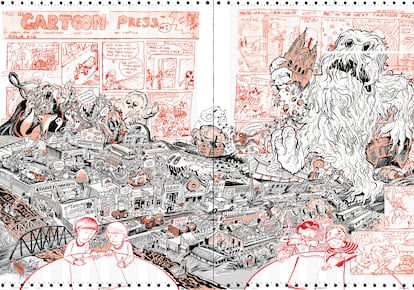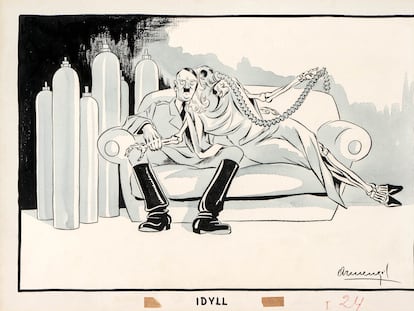Stars, stripes and bullets: How graphic novels help to understand modern America
US comic books have historically captured the reality of the country and they now serve as a way of explaining it and even questioning it

In the 1980s, at a meeting of comic book experts, it was stated that comics were born in the United States on October 25, 1896, with the first speech bubble that appeared in the series Hogan’s Alley, better known as Yellow Kid. Although this statement seems exaggerated and inaccurate, given the many examples that can be traced back to previous centuries in Europe, the truth is that the ninth art was consolidated as a mass medium during the 20th century in the U.S., and that the Richard F. Outcault strip is an extraordinary example of how comics captured the reality of American street society like no other medium, becoming so popular that it would give rise to the term “yellow press” and one of the first media wars between the magnates Joseph Pulitzer and William Randolph Hearst.
Comics in newspapers became a reflection of everyday life and also of politics as seen from the homes of Americans, with series such as Gasoline Alley, which has been published since 1918, while its characters grew up, had children, and died. Cartoons provided the scene of scathing and intelligent political observation from the apparent innocence of the small animals in Walt Kelly’s Pogo (1948-1975), or from the naive ignorance of the hillbillies in the mountains of Li’l Abner (now being revived by the publisher Diábolo in Spain), used as a scalpel by Al Capp for the sharpest criticism. But, without a doubt, the American comic became synonymous with the superhero genre, exported all over the world and today converted into an audiovisual medium.
DC and Marvel comics invaded the public consciousness with a particular vision of American reality, which from the 1970s onward became not only a faithful reflection of its society, but also a critique of it. Characters such as Captain America, often misunderstood by European intellectuals, have been examples along this line, as when in the midst of the Watergate scandal the Secret Empire saga harshly attacked the government’s involvement in corruption. Englehart, Friedrich, Buscema, and Robbins used the character as an emblem not of the flag and the country, but of the democratic values on which the country was based. A method that has been maintained, with the appearance of presidents in the pages of comic books and even open criticism of Donald Trump in series such as Savage Dragon, by Erik Larsen.
Graphic novels can be an excellent way to understand today’s America, which is facing the Harris-Trump duel, and although it is difficult to understand the nuances that characterize the rust belt states from a European perspective, works such as Ginseng Roots by Craig Thompson allow us to understand the context much better.
Halfway between essay and personal catharsis, with a heartfelt tribute to the comics he read as a child, Craig Thompson unravels the reality of an isolated society strongly conditioned by religiosity”
The author of Blankets returns to his own biography, but stops looking inside himself to understand how the context in which he grew up shaped his personality. A broad perspective that studies the surprising specialization in the cultivation of ginseng, which allowed for the establishment of unprecedented and successful commercial relations with Asia for a small area of Wisconsin. Halfway between essay and personal catharsis, with a heartfelt tribute to the comics he read as a child, Thompson unravels the reality of an isolated society strongly conditioned by religiosity, which explains many realities that seem incomprehensible to the European gaze.
With an extraordinary mastery of graphic narrative, which he uses with both didactic and empathetic skill, Thompson dissects a rural and closed society that has continually struggled against adversity, skeptical of politics that is not close to home, but easy to manipulate through populism. The nearly 500 pages of the graphic novel are an effective means of revealing that the Harris-Trump dynamics go far beyond surnames, slogans, or a debate, born of a past and a historical baggage that is difficult to assess from our perspective, and that has less to do with parties than with traditions and a way of understanding family and society that is linked to land and economics.
The ninth art in the U.S. has always been a testimony to its sociopolitical reality and, today, it is a way of understanding and interpreting it through works like Thompson’s.
Sign up for our weekly newsletter to get more English-language news coverage from EL PAÍS USA Edition
Tu suscripción se está usando en otro dispositivo
¿Quieres añadir otro usuario a tu suscripción?
Si continúas leyendo en este dispositivo, no se podrá leer en el otro.
FlechaTu suscripción se está usando en otro dispositivo y solo puedes acceder a EL PAÍS desde un dispositivo a la vez.
Si quieres compartir tu cuenta, cambia tu suscripción a la modalidad Premium, así podrás añadir otro usuario. Cada uno accederá con su propia cuenta de email, lo que os permitirá personalizar vuestra experiencia en EL PAÍS.
¿Tienes una suscripción de empresa? Accede aquí para contratar más cuentas.
En el caso de no saber quién está usando tu cuenta, te recomendamos cambiar tu contraseña aquí.
Si decides continuar compartiendo tu cuenta, este mensaje se mostrará en tu dispositivo y en el de la otra persona que está usando tu cuenta de forma indefinida, afectando a tu experiencia de lectura. Puedes consultar aquí los términos y condiciones de la suscripción digital.
More information
Archived In
Últimas noticias
The new victims of the Republican war on Obamacare: Millions hit by soaring health insurance premiums
A country divided on migrant rights: Some US states expand protections while others restrict them
Venezuela authorizes the release of another 87 political prisoners
There is as much life left to discover on planet Earth as that which is already known
Most viewed
- David King, chemist: ‘There are scientists studying how to cool the planet; nobody should stop these experiments from happening’
- Reinhard Genzel, Nobel laureate in physics: ‘One-minute videos will never give you the truth’
- Oona Chaplin: ‘I told James Cameron that I was living in a treehouse and starting a permaculture project with a friend’
- Sinaloa Cartel war is taking its toll on Los Chapitos
- The Interoceanic Train, the Mexican alternative to the Panama Canal










































